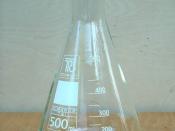Comparing Two Decaffeination Methods 1
Comparing The Caffeine Content Between Coffee and Tea
Klaudine Marie F. Guerrero
Maria Montessori Foundation
Comparing Two Decaffeination Methods 2
Chapter 1
Introduction
Caffeine is an addictive stimulant that stimulates the central nervous system, heart rate, and respiration that is added to soft drinks and other kinds of drinks to add a pleasing bitter taste and becomes an intensely bitter white powder when purified (Helmenstein, chemistryabout.com, 2013).
Decaffeination is the process of extracting caffeine from coffee to produce decaffeinated coffee and tea. Decaffeination is an important industrial process and can be performed using a number of different solvents (news-medical, n.d.). These decaffeination processes are Natural Decaffeination, Ethyl Acetate Decaffeination, Water Decaffeination, and the Carbon Dioxide (CO2) Decaffeination (Berkeley Wellness, 2013).
Methylene chloride and ethyl acetate are two solvents used to extract caffeine from coffee beans (Robust Roasters, n.d.). While the methylene chloride method is the most popular decaffeination process around the world (Robust Roasters, n.d.),
Nescafe, a famous coffee brand in the Philippines, uses the natural water process (Nescafe, n.d.)
The methylene chloride process is said by some people who work in the coffee industry that this certain process retain the flavor of the coffee better than the others (Berkeley Wellness, 2013).
Though decaffeination lessens the content of caffeine in coffee and tea, decaf coffee still has its side effects. These common side effects are acidity, heart problems, and osteoporosis. Acidity is caused because coffee itself is highly acidic and raises the levels of nervous activity in the gastric acids and causes it to hyper-secrete. Heart problems are caused because robusta beans, coffee beans that have more diterpenes, is what is used in the decaffeination processes. Osteoporosis occurs when a person drinks coffee regularly because this causes a person to lose five milligrams of calcium...


